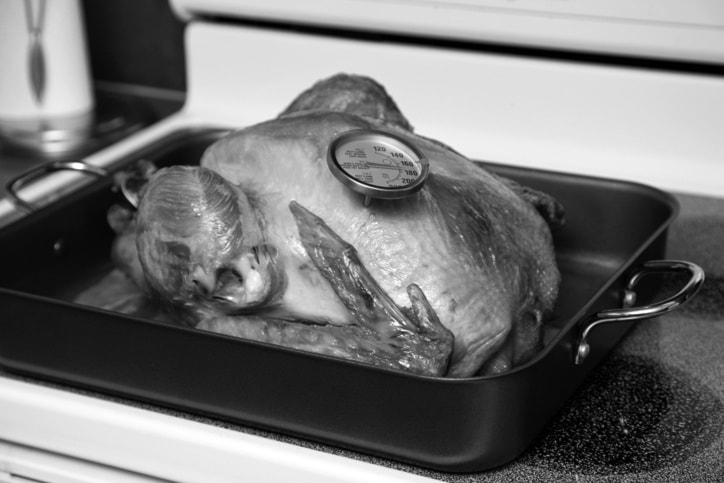When I was asked earlier this week to write this column, I immediately responded with a: “Sure! No problem.”
Then, I started to think about the “perfect turkey” and realized cooking a flawless fowl is as personal and diverse as the number of people willing to eat it.
So, here’s my version of the perfect turkey and you know, if you’ve spent any time at all reading my columns, this is just a guideline to help you towards your own goal — use what you like and toss what you don’t.
First, decide how many pounds of turkey you need for your family, remembering once you have cooked the turkey you will be left with roughly half the original weight due to wastage.
In other words, if you buy a 16-lb gobbler, you’ll get about eight-lbs of white and dark meat. Depending on your family, how much they eat and how much they love leftovers you can decide on anywhere from 6 ounces to 16 ounces per person.
Once you have selected the best bird for you and yours the first step in a wonderfully moist turkey — if you purchased a frozen one — is to thoroughly defrost it.
Below is a table giving times required to defrost your turkey in the refrigerator, where it should always be allowed to thaw.
Weight of turkey with time required to safely thaw in parenthethis:
8 - 12-lbs (2 to 3 days)
13 - 16-lbs (3 to 4 days)
17 - 20-lbs (4 to 5 days)
21 - 24-lbs (5 to 6 days)
Once the turkey is defrosted remember to remove the neck and giblets.
Some people simmer the neck for gravy, some sauté the giblets to serve with the turkey while other’s throw the whole bunch in the garbage in disgust!
Whatever you choose to do with them, do NOT cook them in the turkey.
Now, to stuff or not to stuff this is the question of ages.
I like to stuff my turkey because I believe the juices of the bird make the stuffing taste just that much better and helps keep it nice and moist.
I believe it’s ok to stuff your turkey as long as you follow a simple golden rule: Stuff it immediately before roasting.
Remember, do not over pack the stuffing in the bird as it will swell while cooking and could split your bird or fall out onto the floor of your oven and make a huge, smelly, smoky mess.
Do not ever — under any circumstances — stuff the turkey the night before and place on the counter or in the fridge. You are just asking for all sorts of bacterial broohahas.
Now, after your turkey is completely defrosted and stuffed, dry it off with paper towels and rub the entire bird with olive oil. This helps to brown up the skin and make it crispy.
At this point, the world is your oyster, so to speak.
As turkey is a very mild tasting meat, you can rub into the skin as many or as few herbs as you like.
You can leave it simple and just salt and pepper the turkey or you can go traditional and rub in some dried sage and poultry seasoning or you can separate the skin from the breast meat and layer in some fresh herbs like sage and thyme.
The meat thermometer is the ONLY way to be sure to have a cooked AND moist turkey.
Place the bird uncovered in a preheated 325 F (163 C) oven and cook seven to 11 minutes per pound. If you decided to stuff the bird, extend the time generally by 30 to 45 minutes overall.
Insert the meat thermometer into the meatiest part of the inner thigh from below and parallel to the leg of the turkey, kind of the haunch of the turkey if turkeys had haunches, and pull from the oven when the meat thermometer reads 175 F.
Now, don’t everyone freak out and think I’ve completely lost my mind because everyone knows the internal temperature of the turkey is supposed to be 180 F.
Here’s the reason why you should pull it before then: all meat continues to cook after you remove it from the oven and the turkey will hit the right temperature on the counter.
At this point, you are going to remove the turkey from the pan, place on a rack or cutting board or what have you and make a tinfoil tent to cover the bird for 20 – 25 minutes.
Tenting means just that, taking tin foil and making a crease half way along so that it will stand over the turkey like a tent. Do not crimp the sides down. You should be able to see the turkey.
This allows the turkey to continue cooking without ending up overcooked and dry because the juices of the meat that were forced to the outside of the turkey during the roasting process will have a chance to be reabsorbed into the rest of the bird.
And besides, the 20 to 25 minutes can be used to get the rest of the dinner prepared.
When you are ready, place the lovely, golden brown turkey on a platter and carve it at the table!
Kellie Dukes is a chef who lives in Port Hardy.
